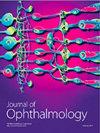miR-26a-5p Attenuates Oxidative Stress and Inflammation in Diabetic Retinopathy through the USP14/NF-κB Signaling Pathway
IF 1.8
4区 医学
Q3 OPHTHALMOLOGY
引用次数: 0
Abstract
Purpose. Diabetic retinopathy (DR) is an ocular disease caused by diabetes and may lead to vision impairment and even blindness. Oxidative stress and inflammation are two key pathogenic factors of DR. Recently, regulatory roles of different microRNAs (miRNAs) in DR have been widely verified. miR-26a-5p has been confirmed to be a potential biomarker of DR. Nevertheless, the specific functions of miR-26a-5p in DR are still unclear. Methods. Primary cultured mouse retinal Müller cells in exposure to high glucose (HG) were used to establish an in vitro DR model. Müller cells were identified via morphology observation under phase contrast microscope and fluorescence staining for glutamine synthetase. The in vivo animal models for DR were constructed using streptozotocin-induced diabetic C57BL/6 mice. Western blotting was performed to quantify cytochrome c protein level in the cytoplasm and mitochondria of Müller cells and to measure protein levels of glial fibrillary acidic protein (GFAP), ubiquitin-specific peptidase 14 (USP14), as well as factors associated with NF-κB signaling (p-IκBα, IκBα, p-, and ) in Müller cells or murine retinal tissues. ROS production was detected by CM-H2DCFDA staining, and the concentration of oxidative stress markers (MDA, SOD, and CAT) was estimated by using corresponding commercial kits. Quantification of mRNA expression was conducted by RT-qPCR analysis. The concentration of proinflammatory factors (TNF-α, IL-1β, and IL-6) was evaluated by ELISA. Hematoxylin-eosin staining for murine retinal tissues was performed for histopathological analysis. Immunofluorescence staining was conducted to determine NF-κB nuclear translocation in Müller cells. Furthermore, the interaction between miR-26a-5p and USP14 was verified via the luciferase reporter assays. Results. HG stimulation contributed to Müller cell dysfunction by inducing inflammation, oxidative injury, and mitochondrial damage to Müller cells. miR-26a-5p was downregulated in Müller cells under HG condition, and overexpression of miR-26a-5p relieved HG-induced Müller cell dysfunction. Moreover, miR-26a-5p targeted USP14 and inversely regulated USP14 expression. Additionally, HG-evoked activation of NF-κB signaling was suppressed by USP14 knockdown or miR-26a-5p upregulation. Rescue assays showed that the protective impact of miR-26a-5p upregulation against HG-induced Müller cell dysfunction was reversed by USP14 overexpression. Furthermore, USP14 upregulation and activation of NF-κB signaling in the retinas of DR mice were detected in animal experiments. Injection with miR-26a-5p agomir improved retinal histopathological injury and weakened the concentration of proinflammatory cytokines and oxidative stress markers in the retinas of DR mice. Conclusion. miR-26a-5p inhibits oxidative stress and inflammation in DR progression by targeting USP14 and inactivating the NF-κB signaling pathway.miR-26a-5p 通过 USP14/NF-κB 信号通路减轻糖尿病视网膜病变中的氧化应激和炎症反应
目的。糖尿病视网膜病变(DR)是一种由糖尿病引起的眼部疾病,可导致视力受损甚至失明。氧化应激和炎症是导致 DR 的两个主要致病因素。近来,不同微RNA(miRNA)在DR中的调控作用已得到广泛验证,其中miR-26a-5p已被证实是DR的潜在生物标志物。然而,miR-26a-5p 在 DR 中的具体功能仍不清楚。研究方法利用暴露于高糖(HG)的原代培养小鼠视网膜 Müller 细胞建立体外 DR 模型。通过相差显微镜下的形态观察和谷氨酰胺合成酶的荧光染色来鉴定 Müller 细胞。利用链脲佐菌素诱导的 C57BL/6 糖尿病小鼠构建了 DR 的体内动物模型。用 Western 印迹法对 Müller 细胞的细胞质和线粒体中的细胞色素 c 蛋白水平进行定量,并测量 Müller 细胞或小鼠视网膜组织中胶质纤维酸性蛋白(GFAP)、泛素特异性肽酶 14(USP14)以及与 NF-κB 信号转导相关的因子(p-IκBα、IκBα、p- 和)的蛋白水平。ROS的产生通过CM-H2DCFDA染色检测,氧化应激标记物(MDA、SOD和CAT)的浓度通过相应的商业试剂盒估算。通过 RT-qPCR 分析对 mRNA 表达进行定量。促炎因子(TNF-α、IL-1β 和 IL-6)的浓度通过 ELISA 进行评估。对小鼠视网膜组织进行苏木精-伊红染色,以进行组织病理学分析。通过免疫荧光染色确定了 Müller 细胞中 NF-κB 的核转位。此外,还通过荧光素酶报告实验验证了 miR-26a-5p 与 USP14 之间的相互作用。结果在HG条件下,miR-26a-5p在Müller细胞中下调,而过表达miR-26a-5p可缓解HG诱导的Müller细胞功能障碍。此外,miR-26a-5p靶向USP14,并反向调节USP14的表达。此外,USP14 的敲除或 miR-26a-5p 的上调抑制了 HG 诱导的 NF-κB 信号的激活。拯救实验表明,miR-26a-5p 上调对 HG 诱导的 Müller 细胞功能障碍的保护作用会因 USP14 的过表达而逆转。此外,动物实验还检测到 USP14 在 DR 小鼠视网膜中的上调和 NF-κB 信号的激活。注射 miR-26a-5p 激动剂可改善 DR 小鼠视网膜组织病理学损伤,并降低促炎细胞因子和氧化应激标记物在视网膜中的浓度。结论:miR-26a-5p 通过靶向 USP14 和使 NF-κB 信号通路失活,抑制 DR 进展过程中的氧化应激和炎症反应。
本文章由计算机程序翻译,如有差异,请以英文原文为准。
求助全文
约1分钟内获得全文
求助全文
来源期刊

Journal of Ophthalmology
MEDICINE, RESEARCH & EXPERIMENTAL-OPHTHALMOLOGY
CiteScore
4.30
自引率
5.30%
发文量
194
审稿时长
6-12 weeks
期刊介绍:
Journal of Ophthalmology is a peer-reviewed, Open Access journal that publishes original research articles, review articles, and clinical studies related to the anatomy, physiology and diseases of the eye. Submissions should focus on new diagnostic and surgical techniques, instrument and therapy updates, as well as clinical trials and research findings.
 求助内容:
求助内容: 应助结果提醒方式:
应助结果提醒方式:


